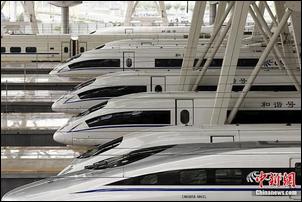(Ecns.cn)--From 200km/hour to 300, China's high-speed railway only took five years – an achievement that took Japan 50 years. As China amazed the world with its "leapfrog" development, the fatal bullet train crash on July 23 near the city of Wenzhou in Zhejiang Province left 40 dead and nearly 200 injured, even though officials claims that China's high-speed rails are the most comfortable and safest trains in the world.
China has since decided to lower the operating speeds for its bullet trains due to safety concerns.
But leapfrog development not only characterizes China's high speed rails. Its effects can be seen throughout the country, from GDP growth to family planning.
Leapfrogging over for high-speed rails?
The fatal train crash finally ended the country's seven-year "great leap forward" in high-speed rail development, according to the National Business Daily (NBD).
In an executive meeting of the State Council presided over by Premier Wen Jiabao on Wednesday, China decided to lower the operating speeds for its bullet trains, as well as reduce ticket prices.
Experts believe the decision is a signal that China is slowing its ambitious high-speed rail program, which has put the country in the same league as Japan and Europe in terms of high-speed rail development, according to a China Daily report.
During the initial stages, trains with a top speed of 350 km/h will be lowered to 300 km/h and trains designed to run up to 250 km/h will operate at 200 km/h, according to the Ministry of Railways.
Rails whose speed was previously raised to 200 km/h will be scaled down to 160 km/h. Ticket prices will also be reduced, but the State Council and the Ministry of Railways did not specify how many lines would be affected.
The country also decided to reevaluate the safety systems of rail projects that have been approved but not yet built, and to suspend the examination or approval of newly proposed projects.
"It's a rational adjustment," China Daily quoted Zhao Jian, a railway expert at Beijing Jiaotong University, as saying. The decision makers have realized the problems that they previously ignored, and in the long term it is a positive move for China's rail development, he added.
This is the second time for China to slow down the trains' speed. Sheng Guangzu, minister of railways, announced the slowing of trains from 350km/h to 300km/h and 250km/h starting from July 1 this year. The speed of high speed rails linking Wuhan-Guangzhou, Zhengzhou-Xi'an, and Shanghai-Nanjing were slowed down, but the Beijing-Tianjin and Shanghai-Hangzhou lines remains at 350km/h.
The leapfrog obsession
In addition to high-speed rails, almost all industries, including military, agriculture, education, real estate, electricity, science, technology and media have all been subject to leapfrog development in China, according to the Southern Weekly.
The concept was first proposed in 1999 by Hu Angang, an economics professor at Tsinghua University. He used it to describe the concept of skipping some stages of development in order to catch up with, or even exceed, other competitors.
According to the Southern Weekly report, at least 15 provinces and municipalities proposed leapfrog development in their 10th Five-Year Plans (2001-2005), most of them located in the central and western parts of the country.
However, use of the word may have gotten out of hand.
For example, it may seem difficult to connect the leapfrog concept with family planning, yet Internet users can find more than 2 million results if they search them together. The Family Planning Commission of Wushan County, in southern China's Chongqing municipality, suggested that it will "realize leapfrog development" to "reduce the birth rate."
The word has also been used by staff members in the funeral and pig breeding industries. A worker at a funeral parlor in Xiangyang of central China's Hubei Province planned to "boost innovation and realize leapfrog funeral development."
When quality and safety are sacrificed in the name of economic development, it may be time for China to reconsider its love affair with the game of leapfrog.


















